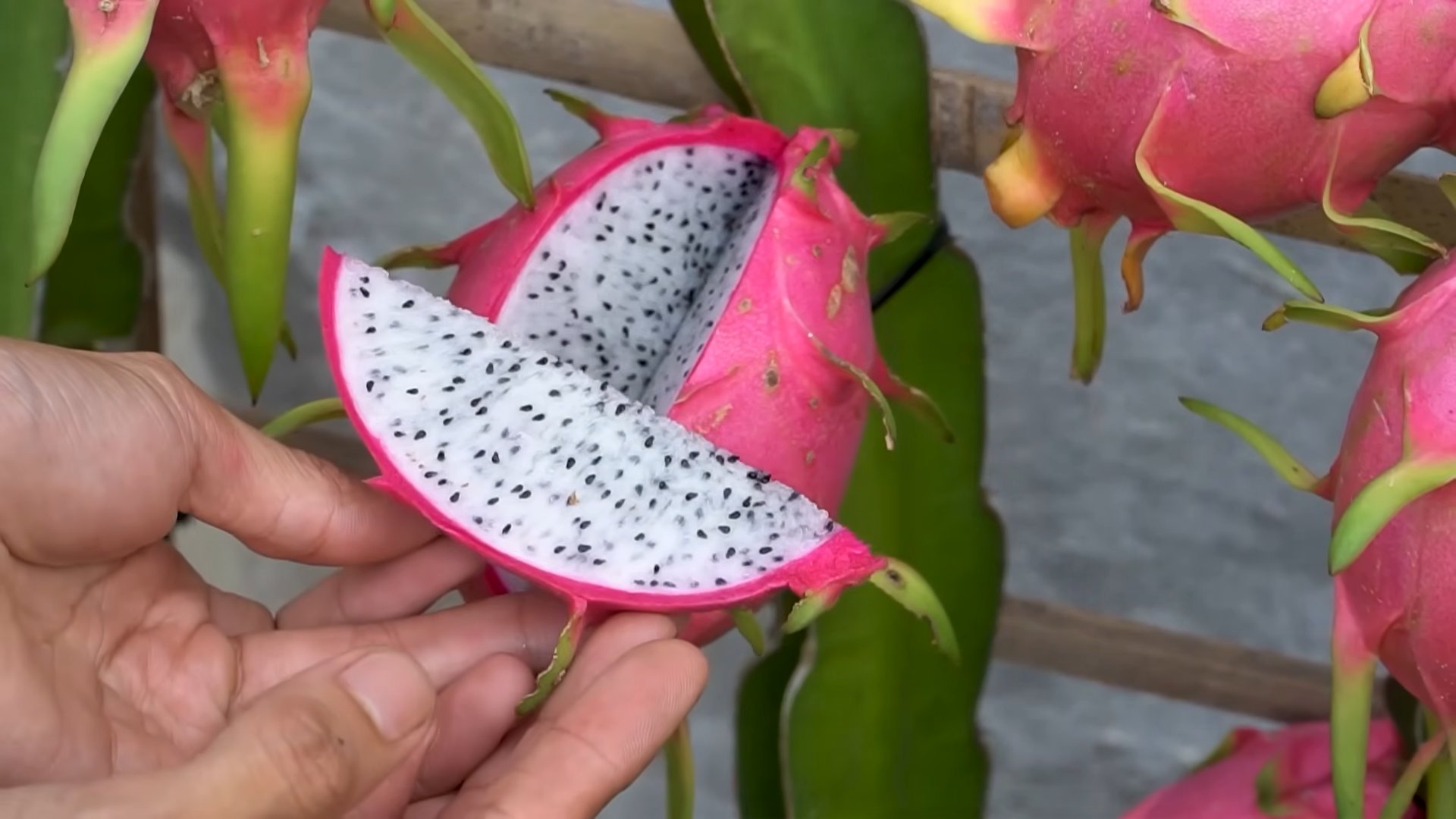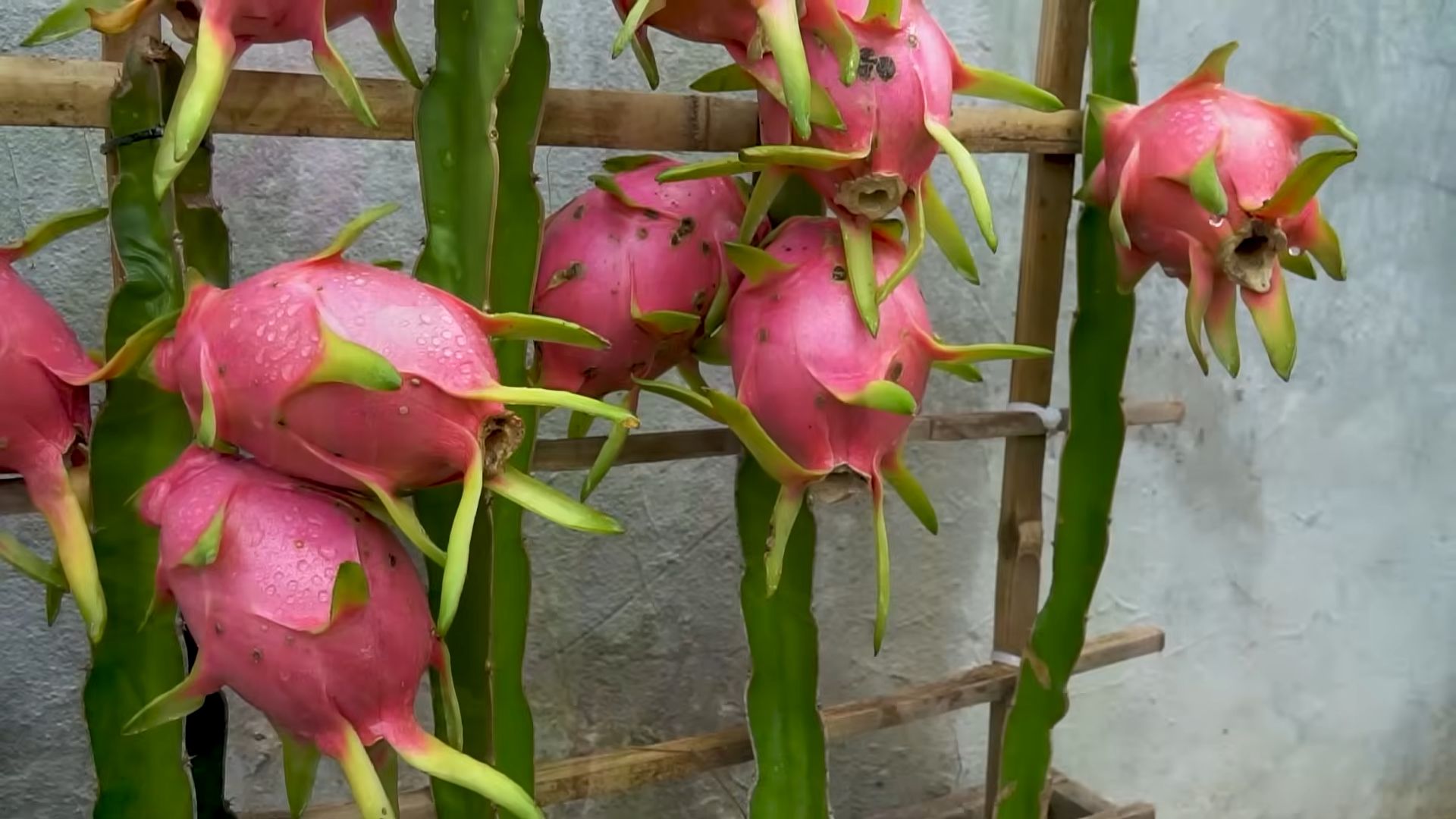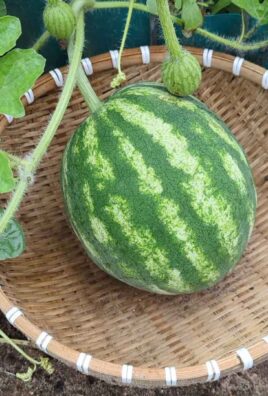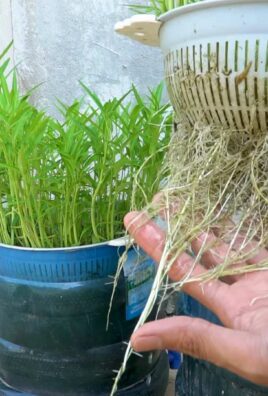Growing Dragon Fruit at Home might sound like an exotic dream reserved for tropical climates, but I’m here to tell you it’s more achievable than you think! Forget those expensive grocery store prices – imagine harvesting your own vibrant, sweet dragon fruit right from your backyard (or even your balcony!).
Dragon fruit, also known as pitaya, has a rich history rooted in Central and South America. For centuries, indigenous cultures have cherished this fruit not only for its delicious taste but also for its medicinal properties. Now, its popularity has exploded worldwide, and I’m excited to share some simple DIY tricks to help you cultivate this fascinating fruit yourself.
Why do you need these DIY hacks? Well, let’s face it, dragon fruit can be a bit finicky. It needs specific conditions to thrive, and understanding those needs is crucial for success. I’ll guide you through everything from choosing the right variety and providing proper support to mastering the art of pollination (yes, you might need to play bee!). With these easy-to-follow tips, you’ll be well on your way to enjoying the unique flavor and health benefits of growing dragon fruit at home. So, grab your gardening gloves, and let’s get started!

Growing Dragon Fruit at Home: A DIY Guide
Okay, dragon fruit lovers, listen up! I’m going to walk you through everything you need to know to grow your own dragon fruit right at home. It might seem intimidating, but trust me, it’s totally doable, and the reward of harvesting your own exotic fruit is SO worth it.
Choosing Your Dragon Fruit Variety
First things first, you need to pick your dragon fruit variety. This isn’t just about taste; it’s about climate and ease of growth. Some varieties are more cold-hardy than others, and some are self-pollinating, which makes your life a whole lot easier.
* **Self-Pollinating vs. Non-Self-Pollinating:** This is HUGE. Self-pollinating varieties, like ‘Hylocereus autofertilis’ or some cultivars of ‘American Beauty’, can produce fruit without needing another dragon fruit plant nearby for cross-pollination. Non-self-pollinating varieties need a compatible partner to produce fruit. If you only want one plant, go for self-pollinating!
* **Fruit Color:** Dragon fruit comes in a rainbow of colors! White flesh with pink skin is the most common, but you can also find red flesh, pink flesh, and even yellow skin with white flesh. The taste varies slightly between varieties.
* **Climate Considerations:** Dragon fruit thrives in warm climates (USDA zones 9-11). If you live in a colder area, you can still grow it in a container and bring it indoors during the winter.
I personally recommend starting with a self-pollinating variety like ‘American Beauty’ or ‘Purple Haze’. They’re relatively easy to grow and produce delicious fruit.
Getting Started: Propagation
You have two main options for starting your dragon fruit journey: from seed or from cuttings. I highly recommend cuttings. Seeds take forever to mature and might not produce fruit true to the parent plant.
* **From Cuttings:** This is the way to go! Cuttings root quickly and will give you a head start. You can often find cuttings at local nurseries or online.
* **From Seeds:** If you’re feeling adventurous, you can try growing from seeds. Just be prepared for a longer wait and potential variations in fruit quality.
Taking Cuttings (If You’re Starting from Scratch)
If you know someone who has a dragon fruit plant, ask if you can take a cutting!
1. **Select a Healthy Stem:** Choose a mature, healthy stem that’s at least 12 inches long.
2. **Make the Cut:** Use a clean, sharp knife or pruning shears to make a clean cut at a 45-degree angle.
3. **Callus the Cutting:** This is important! Let the cut end of the cutting dry out and callus over for about a week. This prevents rot. Place the cutting in a dry, shaded area.
Planting Your Dragon Fruit
Okay, you’ve got your cutting (or seedling), and it’s time to get it planted!
1. **Choose the Right Pot (If Growing in a Container):** Dragon fruit needs a large pot, at least 20 gallons in size. Make sure it has good drainage holes.
2. **Prepare the Soil:** Dragon fruit prefers well-draining soil that’s rich in organic matter. A mix of cactus potting mix, perlite, and compost is ideal. I like to use a ratio of 1:1:1.
3. **Plant the Cutting:** If you’re using a cutting, bury the calloused end about 2-3 inches deep in the soil. If you’re using a seedling, plant it at the same depth it was growing in its original container.
4. **Water Thoroughly:** Water the newly planted dragon fruit thoroughly, but don’t overwater. The soil should be moist but not soggy.
Providing Support
Dragon fruit is a climbing cactus, so it needs support to grow properly. This is crucial for fruit production!
* **Trellis or Stake:** You can use a trellis, a sturdy stake, or even a repurposed tire filled with soil as a support system. The goal is to provide a strong structure for the dragon fruit to climb.
* **Secure the Plant:** As the dragon fruit grows, gently tie the stems to the support structure using soft plant ties or twine. Avoid using wire, as it can damage the stems.
I personally use a sturdy wooden stake with a circular trellis at the top. This allows the dragon fruit to climb up the stake and then cascade down the trellis, creating a beautiful and productive plant.
Caring for Your Dragon Fruit
Now comes the ongoing care. Don’t worry, it’s not too demanding!
1. **Watering:** Water your dragon fruit regularly, especially during the growing season (spring and summer). Let the soil dry out slightly between waterings. Overwatering can lead to root rot. In the winter, reduce watering frequency.
2. **Fertilizing:** Feed your dragon fruit with a balanced fertilizer every 2-3 months during the growing season. Look for a fertilizer that’s high in phosphorus, which promotes flowering and fruiting. I like to use a slow-release fertilizer.
3. **Sunlight:** Dragon fruit needs at least 6 hours of sunlight per day. If you’re growing it indoors, place it near a sunny window or use a grow light.
4. **Pruning:** Prune your dragon fruit regularly to encourage branching and fruit production. Remove any dead or damaged stems. You can also prune to control the size and shape of the plant.
5. **Pest and Disease Control:** Dragon fruit is relatively pest-resistant, but it can be susceptible to mealybugs and scale. Inspect your plant regularly and treat any infestations promptly. Root rot can be a problem if the soil is not well-draining.
Pollination (If Necessary)
If you’re growing a non-self-pollinating variety, you’ll need to hand-pollinate the flowers. This is usually done at night, as dragon fruit flowers bloom at night.
1. **Identify the Male and Female Parts:** The male part (stamen) produces pollen, and the female part (pistil) receives the pollen.
2. **Collect Pollen:** Use a small brush to collect pollen from the stamen of one flower.
3. **Transfer Pollen:** Gently transfer the pollen to the pistil of another flower.
4. **Repeat:** Repeat this process for all the flowers that are open.
Hand-pollinating can significantly increase your chances of getting fruit, especially if you only have one plant.
Harvesting Your Dragon Fruit
This is the most exciting part! Dragon fruit typically takes about 30-50 days to ripen after flowering.
1. **Look for Color Change:** The skin of the dragon fruit will change color from green to bright pink, red, or yellow, depending on the variety.
2. **Check for Softness:** The fruit should be slightly soft to the touch, like a ripe avocado.
3. **Harvest Carefully:** Use a sharp knife or pruning shears to cut the fruit from the stem. Be careful not to damage the plant.
Once harvested, dragon fruit can be stored in the refrigerator for up to a week.
Troubleshooting
Even with the best care, you might encounter some problems. Here are a few common issues and how to address them:
* **No Flowers:** This could be due to insufficient sunlight, lack of fertilizer, or improper watering. Make sure your plant is getting enough sunlight, fertilize it regularly, and adjust your watering schedule as needed.
* **Fruit Rotting:** This is usually caused by overwatering or poor drainage. Make sure your soil is well-draining and avoid overwatering.
* **Pests:** Inspect your plant regularly for pests and treat any infestations promptly.
Enjoying Your Homegrown Dragon Fruit
Congratulations! You’ve successfully grown your own dragon fruit. Now it’s time to enjoy the fruits of your labor!
* **Eat it Fresh:** Simply slice the dragon fruit in half and scoop out the flesh with a spoon.
* **Add it to Smoothies:** Dragon fruit adds a vibrant color and a subtle sweetness to smoothies.
* **Make Dragon Fruit Bowls:** Top a bowl of yogurt or granola with dragon fruit and other fruits.
* **Get Creative!** There are endless ways to enjoy dragon fruit. Experiment and find your favorite!
Growing dragon fruit at home is a rewarding experience. With a little patience and care, you can enjoy delicious, exotic fruit right from your own backyard (or balcony!). Happy growing!

Conclusion
So, there you have it! Growing dragon fruit at home might seem like an exotic endeavor reserved for seasoned gardeners, but as we’ve shown, it’s surprisingly achievable with a little patience and the right approach. The vibrant colors, the unique flavor, and the sheer satisfaction of harvesting your own fruit make the effort incredibly worthwhile. Forget those expensive, often bland, supermarket dragon fruits – imagine biting into a juicy, perfectly ripe dragon fruit that you nurtured from a small cutting or seed. The difference in taste and texture is simply remarkable.
This DIY project isn’t just about saving money; it’s about connecting with nature, learning new skills, and enjoying the fruits (literally!) of your labor. Plus, a thriving dragon fruit plant makes a stunning addition to any garden or patio, adding a touch of the tropics to your space.
But the best part? The possibilities are endless! Experiment with different varieties of dragon fruit. Try growing the white-fleshed varieties for a classic, refreshing taste, or venture into the world of red and pink-fleshed dragon fruits for a sweeter, more intense flavor. You can even explore the yellow-skinned varieties, known for their exceptional sweetness and unique aroma.
Consider different trellising methods to suit your space and aesthetic preferences. A simple wooden stake works well for young plants, but as your dragon fruit matures, you might want to upgrade to a more elaborate trellis system, such as a circular or umbrella-shaped structure. This will not only provide adequate support for the heavy branches but also create a visually appealing focal point in your garden.
Don’t be afraid to get creative with your growing medium. While a well-draining potting mix is essential, you can customize it to suit your specific climate and soil conditions. Adding compost, perlite, or vermiculite can improve drainage and aeration, while incorporating slow-release fertilizer can provide your dragon fruit with the nutrients it needs to thrive.
And remember, growing dragon fruit at home is a journey, not a destination. There will be challenges along the way, but don’t let them discourage you. Embrace the learning process, experiment with different techniques, and most importantly, have fun!
We wholeheartedly encourage you to give this DIY project a try. Start small, be patient, and don’t be afraid to ask for help. The rewards are well worth the effort. Once you’ve harvested your first dragon fruit, you’ll be hooked!
We’d love to hear about your experiences growing dragon fruit at home. Share your tips, tricks, and photos in the comments below. Let’s create a community of dragon fruit enthusiasts and learn from each other. Happy growing!
Frequently Asked Questions (FAQ)
What is the best climate for growing dragon fruit?
Dragon fruit thrives in warm climates with plenty of sunshine. Ideally, temperatures should range between 65°F and 80°F (18°C and 27°C). While dragon fruit can tolerate brief periods of cooler temperatures, prolonged exposure to frost can damage or kill the plant. If you live in a colder climate, you can still grow dragon fruit in a container and bring it indoors during the winter months. Ensure the plant receives ample sunlight, even indoors, by placing it near a sunny window or using grow lights.
How often should I water my dragon fruit plant?
Watering frequency depends on several factors, including the climate, soil type, and size of the plant. In general, dragon fruit plants should be watered deeply but infrequently. Allow the soil to dry out slightly between waterings to prevent root rot. During the growing season (spring and summer), you may need to water more frequently, especially if the weather is hot and dry. In the winter, reduce watering significantly as the plant’s growth slows down. A good rule of thumb is to check the soil moisture level before watering. If the top inch of soil feels dry to the touch, it’s time to water.
What kind of soil is best for dragon fruit?
Dragon fruit plants prefer well-draining soil that is rich in organic matter. A mixture of potting soil, perlite, and compost is ideal. Avoid heavy clay soils, as they can retain too much moisture and lead to root rot. You can also add sand to improve drainage. The ideal pH level for dragon fruit soil is between 6.0 and 7.0.
How much sunlight does dragon fruit need?
Dragon fruit plants need at least six hours of direct sunlight per day to thrive. However, in extremely hot climates, some afternoon shade may be beneficial to prevent sunburn. If you’re growing dragon fruit indoors, place it near a sunny window or use grow lights to supplement natural sunlight.
How long does it take for dragon fruit to produce fruit?
Dragon fruit plants typically start producing fruit within one to three years of planting, depending on the variety and growing conditions. Grafted plants may produce fruit sooner than plants grown from cuttings or seeds. To encourage fruiting, ensure your dragon fruit plant receives adequate sunlight, water, and nutrients. Pruning can also help stimulate fruit production.
What kind of fertilizer should I use for dragon fruit?
Dragon fruit plants benefit from regular fertilization, especially during the growing season. Use a balanced fertilizer with a ratio of 10-10-10 or 20-20-20. You can also use a fertilizer specifically formulated for cacti and succulents. Apply fertilizer every two to four weeks during the growing season, following the instructions on the fertilizer label. Reduce or eliminate fertilization during the winter months.
How do I prune my dragon fruit plant?
Pruning is essential for maintaining the shape and health of your dragon fruit plant. Prune regularly to remove dead, damaged, or diseased branches. You can also prune to control the size and shape of the plant. The best time to prune dragon fruit is after the fruiting season. Use sharp, clean pruning shears to make clean cuts.
What are some common pests and diseases that affect dragon fruit?
Dragon fruit plants are generally resistant to pests and diseases, but they can be susceptible to certain problems, such as scale insects, mealybugs, and fungal diseases. Inspect your plants regularly for signs of pests or diseases. If you detect any problems, treat them promptly with appropriate insecticides or fungicides. Good air circulation and proper watering can help prevent fungal diseases.
How do I pollinate my dragon fruit flowers?
Dragon fruit flowers are typically pollinated by bats and moths at night. However, if you’re growing dragon fruit indoors or in an area with limited pollinators, you may need to hand-pollinate the flowers. Use a small paintbrush to transfer pollen from the stamen (male part) to the pistil (female part) of the flower. Hand-pollination is most effective in the early morning hours when the flowers are fully open.
Can I grow dragon fruit from seed?
Yes, you can grow dragon fruit from seed, but it’s a slower process than growing from cuttings. To grow dragon fruit from seed, extract the seeds from a ripe fruit and wash them thoroughly. Sow the seeds in a well-draining potting mix and keep them moist. Germination typically occurs within one to three weeks. Once the seedlings are large enough to handle, transplant them into individual pots. Keep in mind that plants grown from seed may not produce fruit that is true to the parent plant.





Leave a Comment